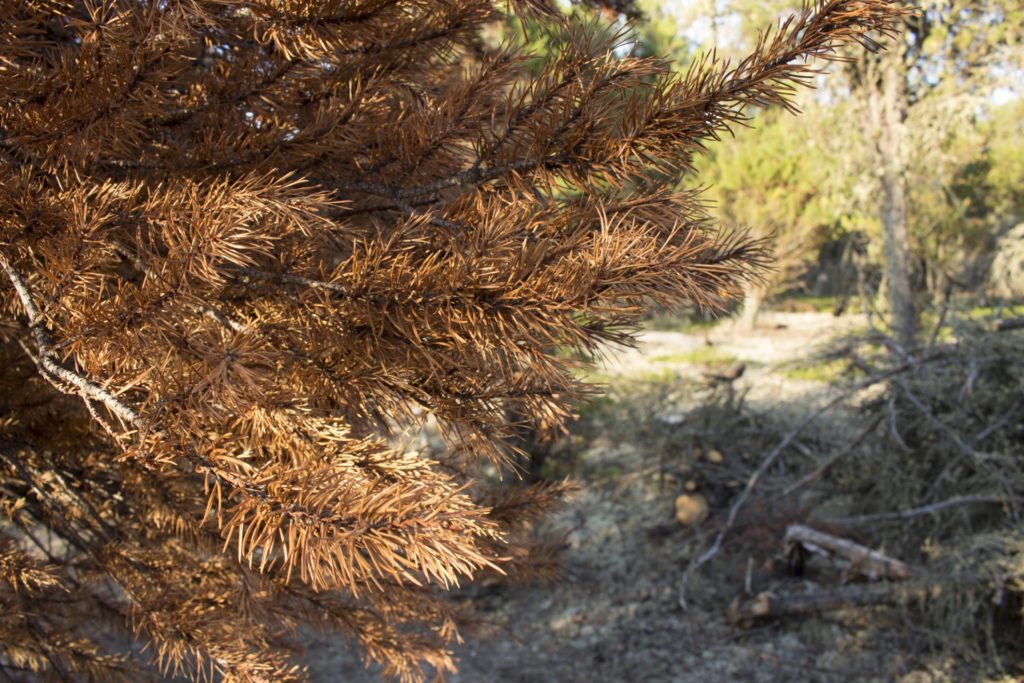Introduction
Red pine scale is a small exotic insect that infests several species of pine. The insect’s preferred host is red pine. Red pine scale was first discovered in 1946, infesting red pine plantations near the Hemlock Reservoir in Easton, Connecticut. The insect is believed to have been introduced to the United States on exotic pines planted at the New York World’s Fair in 1939. By 1950, scale infestations had spread to New York. Additional infestations has since been discovered across much of New England, and several neighboring states.
Distribution & Habitat
Red pine scale is found throughout southern New England, New York, New Jersey, and eastern Pennsylvania.
Hosts
Red pine scale infests red pine, Japanese pine, Japanese black pine, and Chinese pine in nurseries, forests, and landscape settings.
Description
Eggs are small and colored amber-yellow. They are deposited in a white, loosely woven sac attached to the adult’s abdomen. First stage larvae resemble adult females, but are considerably smaller. Projecting from the end of each larva are two long sensory hairs. They range from 0.4 to 0.2 millimeters in length. As the larvae develop, they pass into an intermediate stage. Intermediate stage larvae are elliptical in shape, and lack appendages. They resemble smooth, waxy pods. Adult females are wingless, soft-bodied insects with long legs and antennae. They are brick red in color. Females range from 1/16 to 3/16 of an inch in length. Their bodies are pear-shaped, and coarsely wrinkled. Males are smaller, midge-like insects. They range from 1/32 to 1/16 of an inch long. Males display a set of wings, though they do not use them to fly. Males also have a prominent brush of long, waxy filaments at the end of the abdomen.
Life Cycle
Red pine scale produces two generations each year. The summer generation lay their eggs in May. This generation matures in early August, and lays the fall generation. For the first generation, larvae appear from late spring to early summer. The larvae settle down on host trees, and feed under bark scales. They remain stationary during this period. The first stage larvae transform into intermediate stage larvae by mid-July. Pre-adult males emerge in August, and spin a loosely-woven cocoon, which they briefly pupate in, emerging as winged true adults shortly thereafter. Adult females emerge from the intermediate stage, and propagate. They lay their eggs from August to September. The crawlers that hatch from this batch of eggs represent the fall generation. Upon hatching, the crawlers settle down under bark scales, and overwinter. They break dormancy in April, and develop into intermediate stage larvae. By late spring, they morph into adults.
Symptoms
On trees infested with red pine scale, foliage gradually changes from olive green to light yellow, and finally to a brick red. Discoloration first appears on individual branches on the lower part of the crown, before progressing upwards. New growth may be stunted. When populations are dense, masses of cottony white filaments appear on affected branches. Trees weakened by red pine scale are more susceptible to infiltration from tree pathogens, and other insects, such as bark beetles. Red pine scale, coupled with diseases or bark beetles, can result in rapid tree mortality. Tree mortality occurs soon after the foliage has turned a dark reddish-brown. The bark on infested trees will appear swollen and cracked. If the bark is stripped away, dead tissue will be found beneath each feeding scale.
Management
- Red pine scale has several natural predators, including the anthocoroid bud, Elatophihus inimica, the coccinellid beetle, Mulsantina picta, a hemorobiid, Hemerobius stigmatus, and a chrysopid, Chrysopa. Though each of these insects prey on red pine scale, they are often not abundant enough to effectively limit scale populations.
- There is no effective chemical control for red pine scale. Two applications of a two percent oil emulsion can help prevent infestations on ornamental plantings. The first application should take place in early June, with the second administered in early September.
- Maintain tree vigor through sound cultural practices. Ensure susceptible trees are sufficiently watered, especially during periods of drought. Apply a layer of organic mulch around the base of pines to moderate soil temperature, improve soil quality, and preserve soil moisture.
- Avoid fertilizer applications, as they create favorable conditions for red pine scale.
- Winter harvests of infested trees will reduce the incidence of outbreaks. Logs produced by harvested trees should be pealed. The branches and bark of harvested trees should be burned.
Photo: Public Domain


